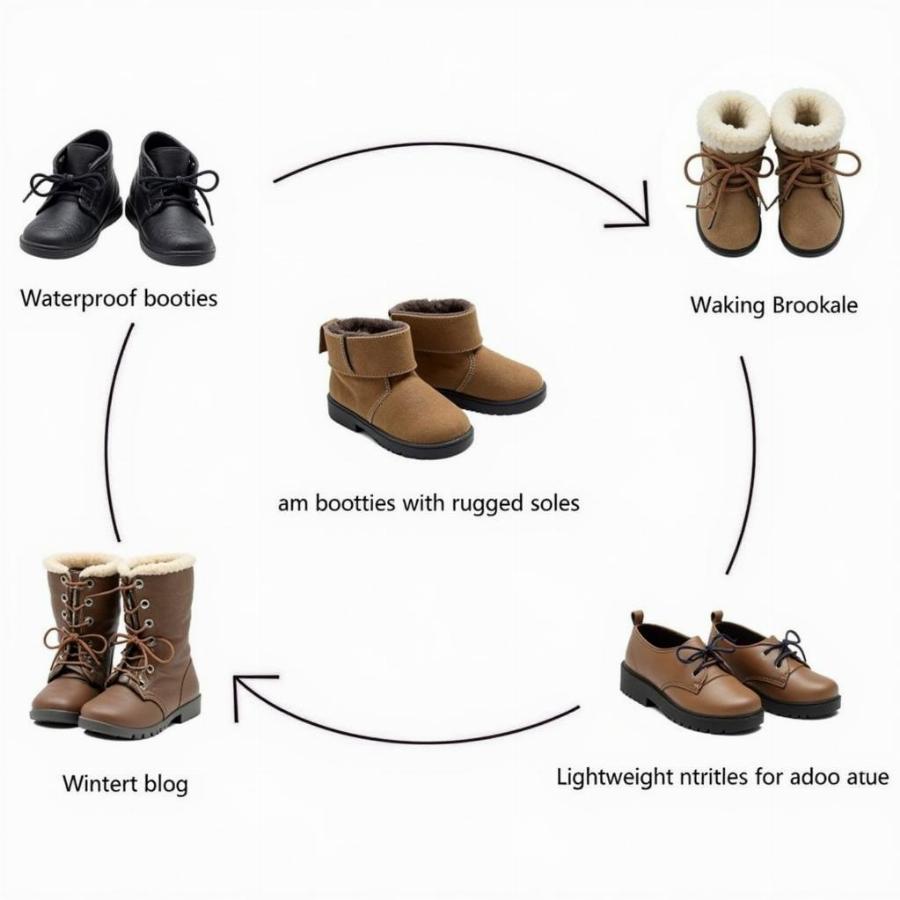Protecting your furry friend’s paws is essential, and booties for dogs feet are a great way to do just that. Whether it’s scorching summer pavements, icy winter walks, or navigating rough terrain, dog booties offer valuable protection and comfort. This comprehensive guide dives deep into everything you need to know about dog booties – from choosing the right fit to getting your pup accustomed to wearing them.
Why Consider Booties for Dogs Feet?
Dog booties, also known as dog shoes or paw protectors, aren’t just a fashion statement. They serve a vital purpose in safeguarding your dog’s paws from a variety of hazards. Think of them as tiny shields against the elements and challenging terrains.
Protecting Paws from Extreme Temperatures
- Hot Surfaces: In the summer, asphalt and concrete can reach scorching temperatures, causing burns and blisters on your dog’s paw pads. Booties provide a protective barrier against these hot surfaces.
- Cold Weather: Winter brings its own set of challenges, with ice, snow, and salt posing threats to your dog’s paws. Booties help keep paws warm and prevent frostbite and cracking.
Shielding Paws from Harsh Environments
- Rough Terrain: Hiking trails, rocky beaches, and even city sidewalks can be tough on dog paws. Booties protect against cuts, abrasions, and other injuries.
- Chemical Exposure: De-icing salts, pesticides, and other chemicals can irritate and even burn your dog’s paws. Booties provide a crucial layer of protection.
Choosing the Right Booties for Your Dog
Finding the perfect fit is paramount. Ill-fitting booties can be uncomfortable and may even fall off.
 Different Types of Dog Booties Available
Different Types of Dog Booties Available
Measuring Your Dog’s Paws
Accurate measurements are essential. Here’s how to do it:
- Place your dog’s paw on a piece of paper.
- Trace around the paw with a pen.
- Measure the length and width of the paw print.
- Consult the manufacturer’s size chart to find the best fit.
Considering Material and Design
- Waterproof Booties: Essential for rainy days and snowy conditions. Look for waterproof and breathable materials.
- Hiking Booties: Designed for rugged terrain, these booties feature durable soles and often have a higher cut for added protection.
- Winter Booties: Lined with fleece or other insulating materials, these booties provide extra warmth in cold weather.
Getting Your Dog Used to Booties
Introducing booties gradually is key. Start by letting your dog sniff and investigate the booties. Then, put them on for short periods, rewarding your dog with treats and praise.
How to clean dog booties?
Cleaning your dog’s booties regularly is essential for maintaining their hygiene and preventing the spread of bacteria. Here’s how:
- Remove any debris or dirt from the outside of the booties.
- Hand wash the booties with mild soap and water.
- Rinse thoroughly and allow to air dry.
When are booties for dogs feet necessary?
Booties are particularly useful in extreme weather conditions, such as hot pavements in summer or icy sidewalks in winter. They also offer protection during hikes on rough terrain or in areas with potential hazards like broken glass or chemicals.
Are there different types of booties for different activities?
Yes, there are various types of booties designed for specific activities. For instance, hiking booties offer robust soles for better grip, while winter booties have insulation for warmth. Check out our article on dog paw wrap for more information on paw protection.
Conclusion
Booties for dogs feet are a valuable investment in your dog’s health and comfort. From protecting paws against extreme temperatures and harsh environments to providing support and stability, dog booties offer numerous benefits. By carefully selecting the right fit, material, and introducing them gradually, you can ensure your furry friend enjoys the benefits of these paw-some protectors. Remember to consult with your veterinarian if you have any concerns about your dog’s paw health. You might also want to explore solutions for dry dog feet.
FAQs
- How do I choose the right size booties for my dog? Measure your dog’s paws carefully and refer to the manufacturer’s size chart.
- My dog keeps trying to take off their booties. What can I do? Introduce the booties gradually, rewarding your dog with treats and praise. Ensure a proper fit to prevent discomfort.
- Are dog booties necessary for all dogs? While not essential for every dog, they offer valuable protection in various situations, especially for dogs with sensitive paws or those living in areas with extreme weather conditions.
- How often should I clean my dog’s booties? Clean them after each use, especially if they’ve been exposed to dirt, mud, or chemicals. For more information on paw care, read our article on cream for paws in dogs.
- Can my dog wear booties indoors? Yes, some lightweight booties are designed for indoor use, providing traction on slippery floors and protecting paws from rough surfaces. If you’re concerned about your dog’s paw odor, you might be interested in reading our article on why do my dogs feet smell like fritos.
- Are there booties for dogs with injuries? Yes, some booties are designed specifically to protect injured paws and aid in the healing process.
- What are some alternatives to booties for dogs feet? Paw wax or balm can provide some protection against the elements, though it may not be as effective as booties in extreme conditions.
Beaut Dogs is your trusted source for all things dog-related, providing comprehensive and reliable information to help you care for your canine companion. For personalized advice and answers to your specific questions, feel free to contact us at Email: [email protected]. Beaut Dogs is dedicated to providing you with the knowledge and resources you need to ensure your dog lives a happy, healthy life.